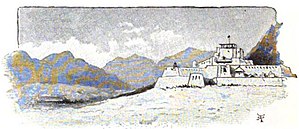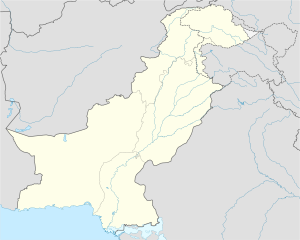This is an old revision of this page, as edited by HistoryofIran (talk | contribs) at 12:04, 21 April 2023 (rv, the typical pov editing this article suffers from. It seems no one reads the infobox, let alone the body of the article. Only took 4 days for this to resume after the protection template expired). The present address (URL) is a permanent link to this revision, which may differ significantly from the current revision.
Revision as of 12:04, 21 April 2023 by HistoryofIran (talk | contribs) (rv, the typical pov editing this article suffers from. It seems no one reads the infobox, let alone the body of the article. Only took 4 days for this to resume after the protection template expired)(diff) ← Previous revision | Latest revision (diff) | Newer revision → (diff) 1837 battle of the Afghan–Sikh Wars| Battle of Jamrud | |||||||
|---|---|---|---|---|---|---|---|
| Part of the Afghan-Sikh wars | |||||||
 A portrait of the Jamrud Fort | |||||||
| |||||||
| Belligerents | |||||||
|
|
| ||||||
| Commanders and leaders | |||||||
|
Akbar Khan Afzal Khan Shams al-Din Khan Mirza Sami Khan Josiah Harlan |
Hari Singh Nalwa † Mahan Singh Mirpuri Mangal Singh Ramgarhia Tej Singh | ||||||
| Strength | |||||||
|
7,000 cavalry 2,000 matchlockmen 9000 guerilla fighters 20,000 Khybers 50 pieces artillery |
800 Jamrud garrison 10,000 relief force/reinforcements | ||||||
| Casualties and losses | |||||||
| 11,000 | Unknown | ||||||
 | |||||||
The Battle of Jamrud was fought between the Emirate of Afghanistan under Emir Dost Mohammad Khan and the Sikh Empire under Maharaja Ranjit Singh on 30 April 1837. Afghan forces confronted the Sikh forces at Jamrud. The garrisoned army was able to hold off the Afghans till Sikh reinforcements arrived to relieve them.
Background
Following the consolidation of the Sikh Empire in Punjab, Maharaja Ranjit Singh had led a wave of invasions on Afghan-held territories, also capitalizing off of Afghan Civil war and began conquering the long-held Afghan territories over the preceding years. This resulted in the Durrani Empire losing the Punjab region, Multan, Kashmir, Derajat, Hazara, Balakot and Attock, whereas Peshawar and Jamrud would later be seized from the Peshawar Sardars in the Battle of Peshawar (1834)
Prelude and battle
Towards the end of 1836, Sardar Hari Singh Nalwa attacked and captured the small, but very strategic, fortified Khyberi village of Jamrud, situated on the south-side of a range of mountains at the mouth of the Khyber Pass. With the conquest of Jamrud, the frontier of the Sikh Empire now bordered the frontier of Afghanistan. In 1837, the Sikh Army was in Lahore where all best generals and troops were recalled from all places including Peshawar for the wedding of Kanwar Nau Nihal Singh, the grandson of Maharaja Ranjit Singh. The Emir of Afghanistan, Dost Mohammad Khan, finding this as the right opportunity, sent his sons with a 7000 cavalry, 2000 matchlockmen, 9000 guerilla fighters and 20,000 Khybers, to drive the Sikhs out of Peshawar. Akbar Khan reached Jamrud, and saw no sign of the Sikh forces, and as a result began to demolish the defenses of the fort. While Akbar Khan's forces were focused on destroying the fortifications, Hari Singh Nawla, the Sikh general, led a charge against the Afghans. The Afghans were sent into disarray with heavy losses, and Akbar Khan's force was relieved by Shams al-Din Khan, who charged the Sikh lines. Akbar Khan reorganized and rallied his men and forced the Sikhs to retreat to the fort of Jamrud. Amidst the fighting, the Sikh general, Sardar Hari Singh Nalwa was mortally injured in the battle and later died after forcing his way into the fort. According to Afghan chronicle Siraj al-Tawarikh, Akbar Khan and Hari Singh Nawla engaged in a duel without recognizing each other. After much thrusting and parrying, Akbar Khan won out and Hari Singh Nawla was knocked to the ground and killed. According to historian Hari Ram Gupta, when Hari Singh rallied his men and rode to the front, he was struck by two bullets, one in the stomach and the other on the side. Mortally wounded he was immediately taken inside the fort where he said to keep his death a secret till the reinforcements arrived. Many eyewitnesses claimed Nalwa ordered his dead body to be hung outside the fort before he died, discouraging the Afghans from attacking, believing Nalwa was still alive. Nevertheless, the Sikh garrison continued holding out until Sikh reinforcements arrived from Lahore, prompting the Afghans to retire from the siege. The battle ended with the retreat of Afghans back to Jalalabad.
Result of the battle
The result of the battle is disputed amongst historians. Some contend the failure of the Afghans to take the fort and the city of Peshawar or town of Jamrud as a victory for the Sikhs. On the other hand, some state that the killing of Hari Singh Nalwa resulted in an Afghan victory. James Norris, Professor of Political Science at Texas A&M International University, states that the battle's outcome was inconclusive.
See also
References
- ^ Maharaja Ranjit Singh: A short life sketch, Ganda Singh, Maharaja Ranjit Singh: First Death Centenary Memorial, (Nirmal Publishers, 1986), 43. Archived 2023-04-10 at the Wayback Machine
- ^ Gupta 1978, p. 179.
- Singh, Khushwant (2004). A History of the Sikhs: 1469-1838. Oxford University Press. p. 286.
- Jean Marie Lafont (2002). Maharaja Ranjit Singh. Atlantic Publishers & Distri. p. 43. Archived from the original on 2023-04-10. Retrieved 2023-03-18.
- Tom Lansford (2017). Afghanistan at War: From the 18th-Century Durrani Dynasty to the 21st Century. p. 21,22. ISBN 9781598847604. Archived from the original on 2023-04-10. Retrieved 2020-10-15.
In 1837, Afghan ruler Dost Mohammed Khan gathered an army to push the Sikhs back from the Khyber pass. They laid siege to the Sikh fort at Jamrud. A Sikh army advanced to relieve the siege, and the two forces met at the Battle of Jamrud. The Sikhs defeated the Afghans. The battle marked the end of the Afghan-Sikh wars.
- Dalrymple, William (2012). Return of a King: The Battle For Afghanistan (Paperback ed.). United Kingdom: Bloomsbury. ISBN 9780307948533.
- Gupta, Hari Ram (1978). History Of The Sikhs Vol. V The Sikh Lion of Lahore. Vol. V. Munshiram Manoharlal. p. 180. ISBN 9788121505154.
- ^ Jean Marie Lafont (2002). Maharaja Ranjit Singh. p. 43. Archived from the original on 2023-04-10. Retrieved 2020-10-15.
In spite of all their efforts, however, the Afghans could neither occupy the fort of Jamrud nor dislodge the Sikhs from their position and gain possession of Peshawar.
- ^ Nalwa, Vanit (2009), Hari Singh Nalwa, "champion of the Khalsaji" (1791-1837), Manohar, p. 177-317, ISBN 9788173047855
- Lee 2019, p. 181-182.
- Lee 2019, p. 209.
- Lee 2019, p. 209-210.
- ^ Lee 2019, p. 210.
- Dalrymple 2012, p. 89.
- Gupta 1978, p. 180.
- Griffin KCSI, Sir Lepel H. (1890). The Panjab Chiefs: Historical and biographical notices of the principal families in the Lahore and Rawalpindi divisions of the Panjab. Vol. II. pp. 87, 89, 90.
{{cite book}}: CS1 maint: multiple names: authors list (link) CS1 maint: numeric names: authors list (link) - Lee 2019, p. 188.
- Several scholars consider the Sikhs to have been victorious:
- Hasrat, Bikrama Jit (1977), Life and Times of Ranjit Singh: A Saga of Benevolent Despotism, V.V. Research Institute Book Agency, p. 137, archived from the original on 2023-04-10, retrieved 2018-12-16,
The doubtful Sikh victory at Jamrud in 1837 had made it clear to Ranjit Singh that policies of hatred and repression in the northwestern frontier so far pursued had failed in its objective.
- Paddy, Docherty (31 July 2010), Khyber pass, Il Saggiatore, pp. 186–187, ISBN 978-88-6576-029-1, archived from the original on 10 April 2023, retrieved 16 December 2018
- Ingram, Edward (1993), "India and the North-West Frontier: The First Afghan War", in A. Hamish Ion; Elizabeth Jane Errington (eds.), Great Powers and Little Wars: The Limits of Power, Greenwood Publishing Group, p. 44, ISBN 978-0-275-93965-6, archived from the original on 2023-04-10, retrieved 2018-12-16,
The second was Peshawar, which controlled the entry to the Khyber Pass and had been seized in 1834 by Ranjit Singh from Dost Mohammed, who tried in 1837 to get it back but lost his chance at the Battle of Jamrud.
- Lee, Jonathan (2019), Afghanistan: A History from 1260 to the Present, Reaktion Books, p. 210, ISBN 9781789140101,
"The Sikhs had beaten the Afghans but in the battle Hari Singh, Ranjit's lifelong friend, had been mortally wounded.
- Hasrat, Bikrama Jit (1977), Life and Times of Ranjit Singh: A Saga of Benevolent Despotism, V.V. Research Institute Book Agency, p. 137, archived from the original on 2023-04-10, retrieved 2018-12-16,
- Other scholars consider the Afghans to have been victorious:
- Roberts, Jeffery J. (2003), The Origins of Conflict in Afghanistan, Greenwood Publishing Group, p. 4, ISBN 978-0-275-97878-5, archived from the original on 2023-04-10, retrieved 2018-12-16: "In 1837 Dost's son, Akbar Khan, led an Afghan army to victory at Jamrud. Akbar, however, did not follow up his success with an advance to Peshawar, and the city remained in Sikh hands."
- Clements, Frank; Adamec, Ludwig W. (2003), Conflict in Afghanistan: A Historical Encyclopedia, ABC-CLIO, p. 74, ISBN 978-1-85109-402-8, archived from the original on 2023-02-07, retrieved 2018-12-16,
Dost Mohammed Khan defeated the Sikhs at the Battle of Jamrud in 1837.
- John, Norris; Norris, J. A. (1967), The First Afghan War 1838-1842, Cambridge University Press, p. 109, ISBN 978-0-521-05838-4, archived from the original on 10 April 2023, retrieved 16 December 2018,
The resulting Battle of Jamrud on 30 April 1837 was a bloody Sikh-Afghan encounter where both sides suffered severe losses. The outcome was largely inconclusive but served to further inflame the continued cross-border feuding and induced the Afghans to seek assistance from the Russian-influenced Persians.
| Pashtun-related topics | |||||
|---|---|---|---|---|---|
| Dynasties | |||||
| Key figures |
| ||||
| Culture | |||||
| Poets | |||||
| Groups |
| ||||
| Topics and controversies | |||||
| Battles and conflicts |
| ||||